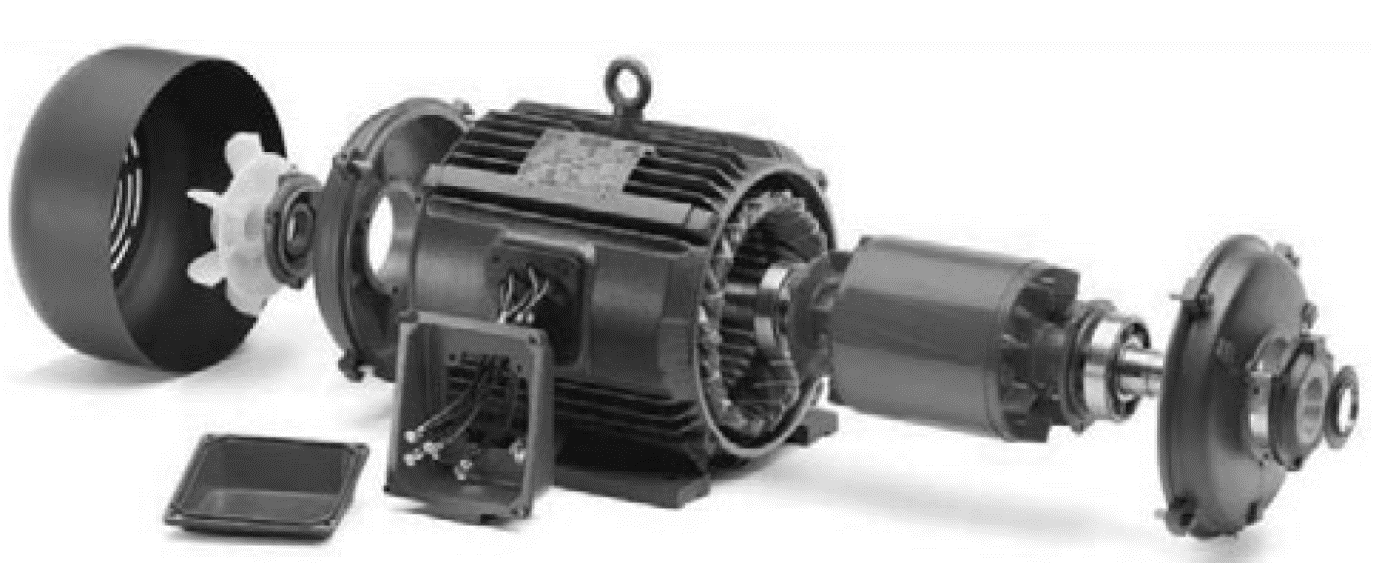In this topic, you study Single Phase Induction Motor – Construction, Diagram, Working Principle, Types, Applications, and Disadvantages.
If one line of a three phase induction motor is opened while the motor is running with moderate or light load, it is found that a three phase induction motor has become a single phase motor. Figure 1 shows the Dismantled view of a single phase induction motor.

Figure 1: Dismantled view of a single phase induction motor.
Construction of Single Phase Induction Motor
A single phase induction motor is similar to a 3-phase squirrel cage induction motor in physical appearance except that the stator has distributed single-phase winding. There is uniform air gap between stator and rotor but no electrical connection between stator and rotor. The single phase induction motor has two main parts one is stator (which is stationary) and other is rotor (which is rotating).
Stator
It is the stationary part of the motor as shown in Figure 2 (a). It has three main parts
- Outer frame
- Stator core
- Stator winding:
Outer frame
Outer body of the motor to support the stator core and the stator windings.
Stator core
The stator core is built up of thin sheets laminations which are usually 0.3 to 0.5 mm thick. The stator core carries the alternating flux which produces eddy current and hysteresis losses.
Stator winding
The stator core carries the Stator winding is connected across a single phase AC supply which produces a rotating magnetic field.
Rotor
It is the rotating part of the motor as shown in Figure 2 (b). This rotor is called squirrel cage, as appear like cage as shown in Figure 2 (b). The rotor has aluminium or copper bars which are permanently circuited at both ends by conducting end rings.

(a) Stator

(b) Rotor
Figure 2 Single-phase induction motor Parts.
Working Principle of Single Phase Induction Motor
A single-phase induction motor with a distributed stator winding and a squirrel-cage rotor is shown in Figure 4. When the stator winding of a single phase induction motor is connected to single phase ac supply, a magnetic field is developed, the axis of this magnetic field is stationary in the horizontal direction as shown in the Figure 4. Currents are induced in the rotor conductors by transformer action, these currents being in such a direction as shown in Figure 3. The force experienced by the upper half conductors opposite to the force on lower half conductors, which have been shown in Fig.3. Thus, no torque is developed at starting. However, it has been observed that if the rotor is given an initial rotation in any direction, the single-phase induction motor develops torque and the rotor continues to pick up speed in that particular direction. Thus a single phase induction motor is not self-starting and needs special starting means.

(a)

(b)
Figure 4: (a) Stationary rotor with the direction of induced emf and current in the rotor conductors, (b) Force Directions on the rotor current carrying upper and lower conductors.
Types of Single Phase Induction Motor
A single-phase induction motor has an alternating field and not a rotating field and, therefore, has no starting torque at all. However, they are made self-starting by providing the various special arrangements which enable them to have a rotating magnetic field at least at starting. Accordingly, the motors are of the following commonly used types. The single phase induction motors can be classified as:
- Split-phase type.
- Reluctance start type.
- Shaded-pole type.
Applications of Single Phase Induction Motor
These motors applications like, electric shavers, ceiling fans, portable drills, vacuum cleaners, washing machines, sewing machines, refrigerators, food mixers, hair driers, etc.
Disadvantages of Single Phase Induction Motor
- Low power factor
- Low efficiency
- Low overload capacity
Specifications for a single-phase induction motor
Specifications for a single-phase induction motor mainly include the following:
Rated output (in watts), speed (in r.p.m., under full-load condition), rated voltage, current rating (it is current drawn by the motor while developing rated output), frequency, class of insulation (commonly used classes are A and B), maximum ambient temperature, duty (it denotes the length of time the motor is expected to be able to carry the rated load under usual service conditions. The motors may be continuously rated or intermittently rated. Intermittently rated Specifications of a Typical Single-Phase Induction Motor
| Type of Motor | Single-Phase, Capacitor-Start, Induction Motor (Open-Type) |
| Rated Output | 200 W |
| Speed | 1420 R.P.M. |
| Rated Voltage | 230 V |
| Current Rating | 2.5 A |
| Frequency | 50 |
| Power Factor | 0.64 lagging |
| Efficiency | 0.63 |
| Number of Phases | 1 |
| Class of Insulation | B |
| Maximum Ambient Temperature | 40o C |
| Duty | Continuous |